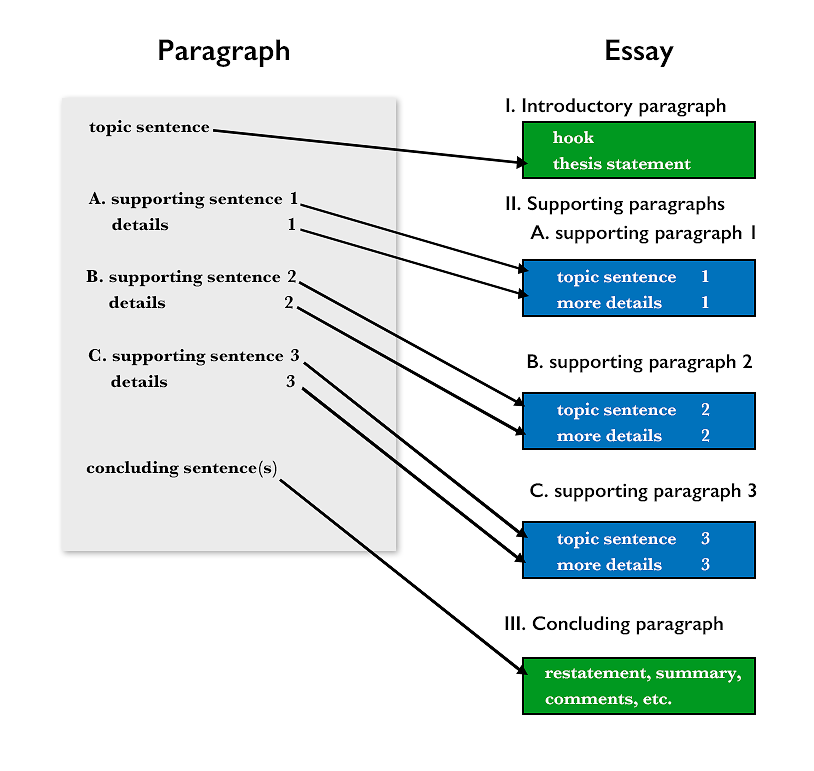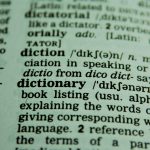Part Two Paragraph Writing Skills and Essay Introduction
Unit 6 Essay Introduction
Learning Objectives
- To learn what an essay is
- To understand the similarities and differences between a paragraph and an essay
- To learn through writing samples how to transition from writing a paragraph to writing an essay
- To understand how the components of an essay relate to each other: hook, thesis statement, introductory paragraph, supporting paragraphs, and concluding paragraph
- To practice writing a five-paragraph essay
I. Warm-up

Read the following paragraph and essay. Discuss the questions that follow.
Paragraph
Places in Making American Friends
There are three places to make friends in the United States. The first place is in the neighborhood. When I visited the U.S. as a child ten years ago, I met an American girl whose house was near mine. We were shy in the beginning but soon started riding our bikes in the neighborhood. We chased[1] each other and had a good time. A few months later, her family moved to another state. I have fond[2] memories of her and think that we will be able to reconnect and renew our friendship if we meet again. Secondly, going to an American school provides an opportunity to make friends. I attended an American elementary school for about six months. I was very nervous about being the only one who looked different. However, some classmates and teachers were kind enough to approach me. They were very understanding even though I did not always understand them. Some of them even helped me with school work and in the gym class. As a young girl in a foreign country, I was very grateful for their friendship. Now I am in America again. I need and value friendship as much as when I was a child. I go to a church once a week and attend a Bible study class where I meet many young adults. There, I have made some friends with whom I talk about not only God but also different cultures. For example, some of them are interested in Japanese music and Anime, so I share some of my favorite music and Anime with them. Sometimes I teach Japanese to them, and they teach English to me. Exchanging information with each other is a good way of establishing and strengthening[3] the relationship. I have learned from my experiences in the neighborhood, school, and church in America over the years that with an open and sincere heart, I am able to find good friends.
By M. Ohbayashi (student), ESL Writing III, Harper College. Used with permission.
Essay
Places in Making American Friends
When I was a child, I had an opportunity to come to the United States a few times to visit my grandmother, uncle, and aunt, who were living in the U.S. Many years later, in January 2020, my mother and I were able to immigrate here. Since I was not an outgoing type of person, I had just a few friends in Japan. However, I have met a lot of Americans and have been able to make friends with some of them. The three places to make friends in the U.S. for me are my neighborhood, school, and church.
The first place is in the neighborhood. When I visited the U.S. as a child ten years ago, I met an American girl whose house was near mine. We were shy in the beginning but soon started riding our bikes in the neighborhood. We chased each other and had a good time. I also went to the pool with my grandmother and her family in summer. Although the pool was deep and I was scared, she and her family helped me enjoy swimming without fear. Besides riding bikes and swimming, we both loved dogs. We each had one. Even the dogs became friends as we played with them with balls. A few months later, her family moved to another state. I have fond memories of her and think that we will be able to reconnect and renew our friendship if we meet again.
Secondly, going to an American school provides an opportunity to make friends. I attended an American elementary school for about six months. I was very nervous about being the only one who looked different. I also did not know how to behave differently in an American school. However, some classmates and teachers were kind enough to approach me. They spoke slowly and patiently with simple English words. They were very understanding even though I did not always understand them. Some of them even helped me with school work and in the gym class. As a young girl in a foreign country, I was very grateful for their friendship. Thanks to them, school became wonderful to me.
Now I am in America again. I need and value friendship as much as when I was a child. I go to a church once a week. One day I met a girl who was studying Japanese. We began to talk with each other. She invited me to a Bible study class, and there I met many young adults. In the beginning, I felt nervous and shy just like the time when I attended the American elementary school for the first time many years before. However, as time went by, I started to like the Bible study class and made some friends with whom I talk about not only God but also different cultures. For example, some of them are interested in Japanese music and Anime, so I share some of my favorite music and Anime with them. Sometimes I teach Japanese to them, and they teach English to me. Exchanging information with each other is a good way of establishing and strengthening the relationship.
Fortunately, I have met many kind Americans who have become my good friends. Though my shyness sometimes stands in the way, I have been trying hard to overcome it by initiating conversations with as many people as possible. I have learned that with an open and sincere heart, I am able to find good friends.
By M. Ohbayashi (student), Writing III, Harper College. Used with permission.
Discussion Questions:
- How do you make American friends? Do you share some of the experiences the writer has described?
- What is the main idea in the paragraph? What is the main idea in the essay?
- How many paragraphs does the essay have?
- What are the three places of making American friends in the paragraph? Are the same three places explained in the essay?
- What does the essay have that the paragraph does not? Do the extra details make the essay better supported and more interesting?
- From the above two pieces of writing, what have you discovered about the similarities and differences between a paragraph and an essay?
- If you could ask the writer one question, what would you ask?
You have learned and practiced how to write well-organized, well-developed paragraphs. Now it is time to expand your writing expertise[4] to essays!
II. Similarities and Differences Between a Paragraph and an Essay
In Unit 3 Parts and Characteristics of a Good Paragraph, you learned that a paragraph is a group of sentences about one main idea. (Open Unit 3 here.)
In this unit, you will learn that an essay is a group of paragraphs about one main idea. An essay can be as short as three paragraphs but as long as many paragraphs that span[5] multiple pages.
Here is a summary of similarities and differences between a paragraph and an essay:
| Similarities | Paragraph | Essay |
|---|---|---|
|
√ | √ |
|
√ | √ |
|
√ | √ |
|
√ | √ |
|
√ | √ |
|
√ | √ |
| Differences | Paragraph | Essay |
|---|---|---|
|
topic sentence, usually in the beginning | thesis statement, usually at end of introduction |
|
some details | more details |
|
one paragraph | three or more paragraphs (In this course, we are studying five-paragraph essays.) |
|
shorter time | longer time |
III. Essay Organization
Essay assignments are very common in college courses. In this course, you are going to learn only the basic concepts and organization of essays that contain five paragraphs. There are other ways of writing built on this basic model, and you will learn them in future semesters.
As you already have much experience writing paragraphs, a good start with essays is to expand[6] an existing paragraph, as you have seen in the beginning of this unit. Below is a structural comparison between a paragraph and an essay.

Read the following paragraph and then the essay. Compare the two by answering the questions that follow.
Paragraph
My Joy in Baking

Baking is my favorite hobby. When I was a child, I liked sweets a lot, especially pastry. Since my mom could not bake, I always went to my friend Natalia’s house to learn baking because her mom was excellent in it. Though the learning process was not that easy, I enjoyed it. I tried and ruined[7] a lot of ingredients, but I did not lose hope. Then I started to get better and better. I tried cupcakes and cookies. It gave me confidence and excitement to think that I could bake for myself. Now I am an adult with a family of my own, and this hobby has not changed. It relaxes me to bake. When I have an exhausting day or feel stressed out, the idea of creating something sweet and fresh makes me feel relaxed. I also like to share the fruit[8] of my hobby with my family and friends. Baking for them gives me joy. To have a happy moment together on any occasion[9] with sweet treats makes my relationship with them stronger. These are all the reasons why baking is my favorite hobby. I would recommend it to anyone who loves sweets and is looking for ways to bring happiness to other people.
By N. Mamurova (student), ESL Writing III, Harper College. Used with permission.
Essay
My Joy in Baking
A hobby is a regular activity performed for enjoyment during spare time. People can choose any hobbies that are right for them: music, sports, cooking, sewing, gardening, and so on. As a child, I liked sweets a lot, especially pastry. This is why baking became and has always been my favorite hobby.
Though the learning process was not easy, I enjoyed it. Since my mom could not bake, I always went to my friend Natalia’s house to learn baking because her mom was excellent in it. I tried and ruined a lot of ingredients, but I did not lose hope. After a few months, I started to get better and better. On Natalia’s 10th birthday, I made pretty cupcakes, even with yellow and pink icings on them. Her mom was very impressed. It gave me confidence and excitement to think that I could bake by myself and bring more happiness to an already joyful event.
Now I am an adult with a family of my own, and this hobby has not changed. It relaxes me to bake. When I have an exhausting day or I am stressed out, the idea of creating something sweet and fresh makes me feel relaxed. Being a mom and a student, my schedule is full. However, nothing else relieves my stress more than baking after a difficult examination at the college: the aroma of butter and sugar, the slowly forming cookies in the oven, and the pleasant and crunching sound as I bite into my creations – all eases the tension of my whole being.
Most importantly, sharing my baking has strengthened my relationship with my family and friends. Enjoying a happy moment together on any occasion with sweet treats gives me joy. Once a friend of mine was sick, but she immediately got much better when I brought her a home-baked, mouth-watering apple pie. I have learned that helping others does not have to be a huge endeavor[10]. Small acts of kindness are just as valuable and meaningful.
A hobby takes time to perfect but brings joy in the process. I am so glad that I have found my pleasure in baking, and I intend to enjoy it for many more years to come. I would recommend it to anyone who loves sweets and is looking for ways to bring happiness to other people.
By N. Mamurova (student), ESL Writing III, Harper College. Used with permission.
Discuss:
| Questions | Paragraph | Essay |
|---|---|---|
|
||
|
||
|
||
|
||
|
||
|
||
|
||
|
IV. Hook, Thesis Statement, Introductory Paragraph
Hook
The word “hook” may remind you of a piece of plastic or metal on the wall on which you can hang your coat. The hook holds the coat and prevents it from falling to the floor. In the same way, a hook in the beginning of an essay aims to hold the readers’ attention so that they keep reading. The main purpose of a hook is to introduce the topic and to get the readers interested.
There are different ways to write a hook. The most common ones are introducing the background or discussing some general information related to the topic.
Discuss the hook in the essays “Places in Making American Friends” and “My Joy in Baking”. Does it introduce the topic and get you interested in reading the essay?
Thesis Statement
The thesis statement is a sentence that contains the main idea of the entire essay.
- A topic sentence shows the main idea of a paragraph. It is usually put in the beginning of a paragraph.
- A thesis statement shows the main idea of an essay. It is usually placed as the last sentence in the introductory paragraph.
The rules for the topic sentence also apply to the thesis statement.
Exercise 1. Use the expressions below to develop thesis statements.
Example:
surprises / U.S.
Thesis statement: I encountered some surprises in my first few weeks of living in the U.S.
1. children / parents’ influence
2. marriage / fights
3. dream job / hard work
4. self-discipline / success
5. bilingual / benefits
6. money / problems
7. government / assisting college students
8. personality / happiness
Exercise 2. Study the introductory paragraph in “Places in Making American Friends” and “My Joy in Baking”. Then choose two of the thesis statements from Exercise 1 to write two introductory paragraphs.
1.
2.
V. Transitions, Supporting paragraphs, and Concluding Paragraph
The principles for the transitions, supporting ideas, and conclusion in a paragraph also apply to an essay. In an essay, there are more supporting details than in a paragraph.
Study and discuss the following outline developed from the example thesis statement in Exercise 1.
| Parts of an Essay | Outline ideas |
|---|---|
| Introductory Paragraph | |
| Hook | my background of coming to the U.S. and love travelling |
| Thesis Statement | I encountered some surprises in my first few weeks of living in the U.S. |
| Supporting Paragraphs | |
| Topic sentence 1 | surprise about nature |
| Details 1 | from airport to house, saw trees, flowers, squirrels, geese, cardinal, not in my country |
| Topic sentence 2 | surprise about customs |
| Details 2 | no air dry laundry outside, dandelions not ok, clean lawn |
| Topic sentence 3 | surprise about friendly people |
| Details 3 | friendly to strangers, parks, stores, smile, not in my country, afraid of getting hurt, teach children |
| Concluding Paragraph | three good surprises about nature, customs, people. Like US, second home. |
Exercise 3. Use the above outline as an example. From the two topics you worked on in Exercise 1 and Exercise 2, write an essay outline for each.
#1
| Parts of an Essay | Outline ideas |
|---|---|
| Introductory Paragraph | |
| Hook | |
| Thesis Statement | |
| Supporting Paragraphs | |
| Topic sentence 1 | |
| Details 1 | |
| Topic sentence 2 | |
| Details 2 | |
| Topic sentence 3 | |
| Details 3 | |
| Concluding Paragraph |
#2
| Parts of an Essay | Outline ideas |
|---|---|
| Introductory Paragraph | |
| Hook | |
| Thesis Statement | |
| Supporting Paragraphs | |
| Topic sentence 1 | |
| Details 1 | |
| Topic sentence 2 | |
| Details 2 | |
| Topic sentence 3 | |
| Details 3 | |
| Concluding Paragraph |
VI. More Essay Examples
Read the two essays below. The first one is developed from an earlier outline. As you read, discuss the questions:
Discuss:
- What is the hook? Is it interesting?
- What is the thesis statement? Where is it located?
- In each body paragraph, what is the topic sentence? What are the details?
- What transition does the writer use in the beginning of each body paragraph?
- Is the paragraph mainly enumerative or narrative in organization? How do you know? In what order are the supporting paragraphs organized (order of importance or chronological order)?
- Does all the information in the body paragraphs support the thesis statement?
- What types of information does the writer use in the conclusion?
- What do you like about this essay?
- How would you improve the essay?
- If you could ask the writer one question, what would you ask?
VII. Unit Review Practice: An Essay Writing Assignment
Now you are ready to write your own essay! As you have learned in Unit 2 The Writing Process (Open Unit 2 here), the best way to plan a paragraph is to follow the proper steps.
An Essay Writing Assignment
Purpose: To show your understanding of planning and writing an essay. Use the writing process to help you.
Topic: You have three choices from below.
Brainstorm and Outline: Brainstorm for ideas. Then organize the ideas by using the outline template below to make an outline. Your outline is due on _________. Bring it to class.
Essay: Your essay should have a title, an introductory paragraph with a hook and a thesis statement, 3 supporting paragraphs each starting with a topic sentence followed by lots of details, and a concluding paragraph. Use appropriate transitions to connect the supporting paragraphs. There should be a total of 5 paragraphs in the essay.
Format: Type your essay, double spaced, font size 12, with 1-inch margins on four sides of the page. Type your name, class, and date on the upper right-hand corner of the page. The first line of each paragraph should be indented. Save your essay in a Word file.
Self Checklist: When you finish writing, use the Self Checklist below. Put a checkmark beside each item if you think you did a good job in that area. Otherwise, improve your essay until you can check off the item. Save your work again.
Submission: Submit your essay on the Blackboard. Go to your Blackboard course site and follow the instructions there. Due by __________.
You have three choices for your topic.
Choice 1:
Choose one of the paragraphs you have written in this course and expand it into an essay.
Choice 2:
Choose one of the thesis statements, introductory paragraphs, and outlines in Exercise 1, 2, and 3 in this unit. Then write an essay based on your outline.
Choose 3:
Choose one of the following new topics. If you plan to have a different one, please talk with your professor first.
-
-
- What are the three things that you want to change about Harper College?
- What are the three things (or events, or people) you wish to forget?
- What are the three most important ways people in your country express love?
- What has been the most memorable day in your life?
- How did you overcome a challenge in your life?
-
Essay Outline Template
| Parts of an Essay | Outline ideas |
|---|---|
| Introductory Paragraph | |
| Hook | |
| Thesis Statement | |
| Supporting Paragraphs | |
| Topic sentence 1 | |
| Details 1 | |
| Topic sentence 2 | |
| Details 2 | |
| Topic sentence 3 | |
| Details 3 | |
| Concluding Paragraph |
Essay Self Checklist
| Questions | Essay Revising and Editing Self Checklist | √ |
|---|---|---|
| 1 | Is my essay clear to understand? | |
| 2 | Do I have an interesting hook and a clear thesis statement? Is the thesis statement located at the end of the introductory paragraph? | |
| 3 | Did I begin each supporting paragraph with a topic sentence? Did I include lots of details in each paragraph? | |
| 4 | Did I connect the supporting paragraphs with appropriate transitions? | |
| 5 | Did I include a concluding paragraph? | |
| 6 | Did I try my best to use correct sentence structure (simple, compound, complex)? | |
| 7 | Did I try my best to use correct grammar such as nouns, pronouns, word form, word order, and others? | |
| 8 | Did I try my best to have correct spelling, punctuation, and capitalization? | |
| 9 | Did I follow the proper paragraph format? |
Note: #6 – #8 may include more specific aspects of grammar depending on how many editing units you have already studied.
NSNT Practice

Go to The NSNT Free Writing Approach and Additional Weekly Prompts for Writing in Appendix A. (Open Appendix A here.) Choose two topics that you have not written about. You may start with the NSNT approach. Then revise and edit at least one of them into an essay. You are encouraged to share your writing with your partner and help each other improve.
Vocabulary Review

The words here have appeared in this unit. The best way to learn them is to guess the meaning of each word from the context. Then hover your computer mouse over the number beside each word to check its meaning and part of speech. These words are also listed in the footnote area at the end of each unit.
Here, you can use the flashcards below to review these words.
Summary
- An essay is a group of paragraphs about one main idea. It consists of a title, an introductory paragraph with a hook and a thesis statement, a few supporting paragraphs, and a concluding paragraph.
- A hook consists of a few sentences to introduce the topic and to get readers interested in the essay.
- A thesis statement is a sentence containing the main idea of the entire essay. It is usually placed at the end of the introductory paragraph.
- Transitions are used to provide connections between supporting paragraphs.
- Paragraphs and essays share some common features. They both focus on one central idea which is explained and developed through supporting ideas and details.
Media Attributions
- people pressing hands together © Photo by Hannah Busing on Unsplash
- comparing paragraph and essay structures © Lin Cui is licensed under a CC0 (Creative Commons Zero) license
- 5 cupcakes with sprinkles © Photo by Brooke Lark on Unsplash
- a pen writing in a notebook © Photo by Aaron Burden on Unsplash
- a page in a dictionary © Pixabay
- chase: verb, run in order to catch someone ↵
- fond: adjective, good, loving ↵
- strengthen: verb, make or become strong ↵
- expertise: noun, expert knowledge and skills ↵
- span: verb, cover, extend to ↵
- expand: verb, make bigger or longer ↵
- ruin: verb, destroy, waste ↵
- fruit: noun, products, results ↵
- occasion: noun, situation ↵
- endeavor: noun, many efforts, hard work ↵

